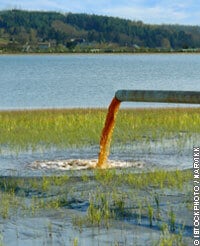What Oercent Of Animals Raised For Food Are On Factory Farms
How the Sickness Spreads
Animals on manufactory farms generate many times the amount of excrement produced by the unabridged U.S. population, and this waste pollutes the air we breathe and the water we drink. Every second, our nation's manufacturing plant farms create roughly 89,000 pounds of waste, which contains highly full-bodied chemical and bacterial toxins—all without the benefit of waste-handling systems. Co-ordinate to a contamination study conducted by Minnesota agricultural extension engineer John Chastain, "The data indicates that the pollution strength of raw manure is 160 times greater than raw municipal sewage."
This waste product is commonly dumped into sprawling chocolate-brown lagoons to rot, or else it is sprayed over fields, allowing harmful chemicals and leaner from the sewage to toxicant our air and h2o every day. According to the Centers for Affliction Control and Prevention (CDC), "[C]hemical and infectious compounds from swine and poultry waste are able to drift into soil and h2o." This untreated waste oftentimes sickens the people who work on or alive almost factory farms.

Muddy Air
Toxic gases and leaner from animal excrement enter the air and are distributed over a very wide expanse past the current of air. When the cesspools that hold tons of animal urine and feces are full, mill farms frequently circumvent pollution limits by spraying liquid manure into the air, creating mists that are spread past the wind.People for miles around are forced to inhale the toxins and pathogens from the sprayed manure and, as a consequence, can endure health problems ranging from asthma and encephalon harm to nascency defects and premature death.
Dingy Water
People who live near factory farms face the constant threat that run-off from the farms will toxicant their waterways, bringing serious illness and fifty-fifty death to their communities. "The water in those areas is non in good shape, and the principal crusade of the [pollution] is not septic tanks, treatment plants, or fertilizer—information technology's manure, mainly from large farms," said Robert Miltner, an aquatic biologist for the Environmental Protection Agency in Ohio.
A study found that a major river in Colorado has loftier levels of three antibiotics that are used exclusively in farmed animals.Outbreaks of E. coli closed half of Iowa's beaches during the summer of 2001, and the water in Des Moines' Raccoon River has nitrate levels that are almost double the limit allowed for drinking water. Large farms are implicated in both of these bug. In 2000, an Due east. coli outbreak in Walkerton, Ontario, left seven people dead—experts cite cow manure that seeped into the town's water supply as a likely cause of the tragedy.
Scientists believe that 3.2 billion pounds of raw sewage from chicken farms on the Delmarva Peninsula caused an outbreak of pfiesteria in the Chesapeake Bay in 1997. The contagion killed 30,000 fish and caused memory loss, pare lesions, and respiratory problems in people who were exposed to the h2o.
How Factory Farms Affect Human Health
Factory farms and the contamination that they produce crusade illnesses in humans that range from brain impairment and depression to miscarriage and nascence defects. They are also responsible for antibody-resistant bacterial infections and astringent respiratory problems. Politicians and government agencies continue to ignore the growing threat that these farms pose to our health and to the surround because of the combination of powerful meat manufacture lobbyists in Washington, large campaign contributions from the meat and dairy industries to central legislators, and executive agencies (eastward.g., the U.South. Department of Agronomics) that hire meat and dairy manufacture representatives to fill crucial posts.
Brain Impairment and Low
Scientists take shown that at that place is a link between exposure to the toxic chemicals found in beast waste and the evolution of neurological problems, including brain harm and depression. According to Academy of Southern California toxicology professor Dr. Kaye H. Kilburn, the "coincidence of people showing a pattern of harm and being exposed to hydrogen sulfide arising from lagoons where hog manure is stored and then sprayed on fields or sprayed into the air" has a "practically undeniable" connectedness to neurological disorders in communities around the farms.
In an investigative study published in The New York Times, Ohio resident Robert Thornell discussed the permanent brain harm that he suffered when a manufacturing plant farm was built near his habitation. "It's like I have a 2.1 gigahertz torso with a 75 megahertz mind," he said. "I experience similar collateral damage." When Thornell's wife was also diagnosed with encephalon damage, the couple was forced to move away from their home in order to prevent further deterioration of their wellness.
Fumes from manure pits have also been linked to severe depression. In a oral communication at the American Veterinarian Medical Clan, Dr. Kelley Donham, director of the University of Iowa'due south Center for Agronomical Safety and Health, cited numerous studies that institute unusually high rates of depression and feet amidst people who alive near factory farms. A North Carolina study also found high rates of depression and fatigue in the neighbors of a pig farm.
Miscarriage and Nascency Defects
Living near a factory farm can be catastrophic for pregnant women. For case, the CDC believes that manure from a factory farm seeped into the groundwater of a small Indiana town and caused at to the lowest degree vii miscarriages.
A joint study by the U.S. Geological Survey and the Oklahoma Department of Agriculture states that ingesting water with nitrate levels above 10 milligrams per liter tin can cause "bluish babe" syndrome (methemoglobinemia), which is a status that prevents blood from carrying oxygen and which can lead to "increased rates of stomach cancer, nativity defects, miscarriage, leukemia, non-Hodgkin's lymphoma, reduced trunk growth and slower reflexes, and increased thyroid size." According to the report, nitrate levels in a "manure lagoon" on a typical pig manufactory farm mensurate an incredible 300 milligrams per liter, which is a level that creates a substantial threat to families who drink from nearby water sources.
Respiratory Problems
Beast waste product emits ammonia, hydrogen sulfite, methane, volatile organic compounds, and particulate matter from fecal dust. These irritants enter the lungs of anyone who is nearby and can cause serious respiratory illnesses.
A February 2002 study conducted by Iowa State University and the University of Iowa Report Group establish that as many as 70 percent of U.S. factory farm workers suffer from acute bronchitis, and 25 percent battle chronic bronchitis. Fifty-fifty more than agonizing, a recent University of Iowa study found that an amazing 46 percent of children who live on squealer factory farms with more than 500 pigs suffer from asthma. On manufacturing plant farms where antibiotics are used as a growth stimulant, the asthma charge per unit in children climbs to more than than 55 percent.
Bacterial Infections
Manufacturing plant farm employees and people in the surrounding communities are frequently exposed to animal excrement and the dangerous leaner it can deport—leaner like E. coli, salmonella, and campylobacter.
On the Delmarva Peninsula in Maryland, Dr. Ellen Silbergeld found that more than twoscore percent of "chicken catchers" and more than 50 percent of processing plant workers were infected with campylobacter, a blazon of leaner that causes diarrhea and abdominal pain and that can sometimes prove fatal. When a group of community members was tested for the bacterium, every person who was tested had a "positive" result.
Residents of a region known as "Feedlot Alley" in Alberta, Canada, accept the highest rates of Due east. coli infections in the province, and E. coli killed almost a dozen children there in 1 3-year menses. Dangerous germs from the excrement of farmed animals have sickened unabridged communities. A 1993 outbreak of cryptosporidium in Milwaukee sickened 403,000 people and killed 104 others. Scientists blamed the tragedy on animal excrement from nearby factory farms.
Antibiotic-Resistant Leaner
Mill farms are also breeding grounds for antibody-resistant bacteria, which are known as "supergerms." On farms beyond America, the antibiotics that we depend on to treat human illnesses are now used to promote growth in animals and to keep them alive in horrific living weather condition that would otherwise kill them. Countless new strains of antibiotic-resistant bacteria have developed as a result of this calumniating practice.
Roughly seventy percent of the antibiotics used in the Usa each yr are given to animals who are used for food. What does this mean for you? It ways that when you go ill, the antibiotics your doctor prescribes may no longer work.
Vancomycin, a drug that is known as a "last defense" in fighting the mortiferous blood infections and pneumonia acquired by staphylococcus bacteria, is becoming obsolete because resistant strains have developed in farmed animals who are given the medicine as a growth stimulant. Similarly, the antibiotic used to treat campylobacter infections in humans is becoming worthless—even as these infection rates rise.
Swine Flu
U.S. health officials declared a public wellness emergency on Sunday, April 26, 2009, in response to the swine-flu outbreak. Cases have been confirmed in the U.South., Mexico, and Canada, and countries from Spain to New Zealand are investigating cases of the flu strain. There is speculation that the swine influenza originated on pig factory farms.
The science is articulate: Eating brute-derived products is harming communities, public health, and the Globe. Request your free vegetarian/vegan starter kit now to showtime on the road to a healthy, sustainable diet.
Source: https://www.peta.org/issues/animals-used-for-food/health-risks-meat-industry/
Posted by: keslercontold.blogspot.com


0 Response to "What Oercent Of Animals Raised For Food Are On Factory Farms"
Post a Comment